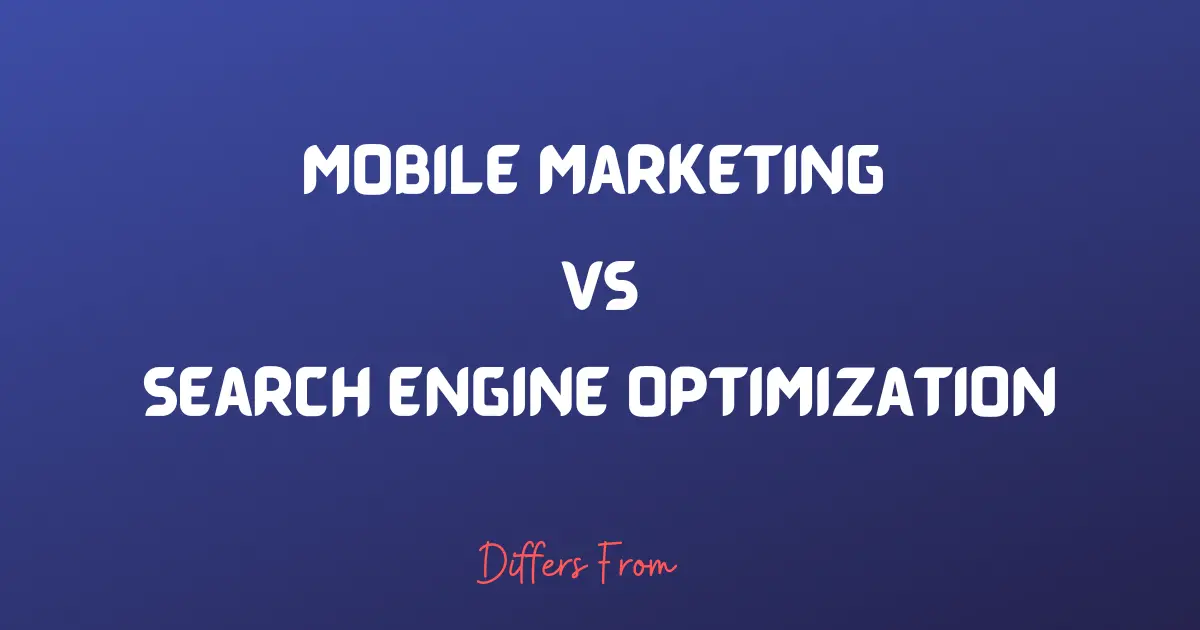In the ever-evolving realm of digital marketing, two key players take center stage: mobile marketing and search engine optimization (SEO).
As businesses strive to make their mark in the online landscape, understanding the fundamental disparities between these two strategies becomes imperative. Imagine mobile marketing as the vibrant street market where your business showcases its offerings, while SEO acts as the invisible guide, directing customers to your virtual storefront.
Join us on a journey as we unravel the distinct characteristics of mobile marketing and SEO, exploring how each contributes uniquely to the success of your online presence.
Let’s delve into the world where mobile devices and search engines play pivotal roles in shaping the destiny of your digital endeavors.
Difference between mobile marketing and search engine optimization
| Mobile Marketing | Search Engine Optimization | |
| Objective and Focus | Primarily focuses on promoting products and services directly to mobile users through various channels like apps, SMS, social media, and mobile-friendly websites. | Aims to enhance a website’s visibility on search engines, making it easier for users to find relevant content when they perform online searches. |
| User Interaction | Emphasizes engaging users directly on their mobile devices, leveraging features like push notifications, in-app advertisements, and mobile-specific campaigns. | Centers on optimizing website content and structure to improve organic search rankings, enabling users to discover the site through search engine results. |
| Mediums Utilized | Encompasses a range of channels such as mobile apps, mobile websites, SMS marketing, QR codes, and location-based services. | Primarily involves website optimization, content creation, link building, and keyword strategies to boost visibility on search engine results pages. |
| Cost Structure | Involves costs related to running advertising campaigns, mobile app development, and maintaining a presence on social media platforms. | Involves initial setup costs for optimization, but ongoing costs are generally lower compared to continuous paid advertising. |
| User Experience | Emphasizes creating a seamless and enjoyable experience for users interacting with content on mobile devices. | Prioritizes user-friendly websites with easy navigation and relevant content to enhance the overall user experience. |
| Measurement Metrics | Metrics include app downloads, click-through rates, conversion rates, and engagement metrics on social media. | Metrics involve website traffic, keyword rankings, bounce rates, and conversion rates from organic search traffic. |
| Adaptability to Trends | Quickly adapts to new mobile technologies and trends, such as augmented reality (AR) and location-based marketing. | Evolves with changes in search engine algorithms, user search behavior, and emerging technologies like voice search. |
| Geographic Targeting | Often incorporates location-based targeting to deliver relevant content or promotions based on a user’s geographical location. | Provides global visibility but can be optimized for local searches through strategies like local SEO. |
| Ownership and Control | Gives businesses more control over their marketing messages and campaigns, as they manage their mobile apps and direct communication channels. | Relies on third-party search engines, and businesses have less direct control over how their content is ranked and displayed. |
| Audience Targeting | Targets a specific audience through personalized campaigns based on mobile user behavior, location, and preferences. | Aims to reach a broader audience by optimizing content with relevant keywords that align with users’ search queries. |
What is mobile marketing?
Mobile marketing refers to promotional activities and strategies designed specifically for mobile devices such as smartphones and tablets.
It involves reaching and engaging with the target audience through mobile channels like SMS, mobile apps, social media, and mobile websites.
Mobile marketing aims to deliver personalized and location-based advertising, enhance customer experiences, drive conversions, and increase brand awareness, ultimately capitalizing on the widespread use of mobile devices in today’s society.
What is search engine optimization?
Search engine optimization (SEO) is the practice of improving a website’s visibility and ranking in search engine results pages (SERPs).
It involves optimizing various aspects of a website, including content, meta tags, images, and site structure, to make it more search engine friendly.
The goal of SEO is to increase organic (non-paid) traffic to a website, enhance user experience, and attract relevant visitors through improved visibility on search engines like Google, Bing, and Yahoo.
Comparison between mobile marketing and search engine optimization
Mobile marketing and search engine optimization (SEO) are both digital marketing strategies, but they have distinct focuses and approaches. Here’s a comparison between the two:
Mobile Marketing: Mobile marketing involves promoting products, services, or brands to mobile device users through various channels, such as mobile apps, SMS, MMS, mobile websites, and in-app advertisements.
Search Engine Optimization (SEO): SEO refers to the process of optimizing a website’s content and structure to improve its visibility and ranking on search engine results pages (SERPs), aiming to increase organic (non-paid) traffic.
Target Audience
Mobile Marketing: Mobile marketing primarily targets mobile device users, as it leverages mobile-specific channels and platforms.
SEO: SEO aims to attract a broader online audience by improving a website’s visibility on search engines, including both desktop and mobile users.
Channels and Tactics
Mobile Marketing: Mobile marketing employs various channels, including mobile apps, SMS marketing, push notifications, mobile display ads, in-app advertisements, and mobile websites.
SEO: SEO focuses on optimizing a website’s on-page factors (content, meta tags, URLs, etc.) and off-page factors (backlinks, social signals, etc.) to improve its organic search rankings. Tactics include keyword research, content optimization, link building, technical SEO, and user experience enhancements.
Goals
Mobile Marketing: The primary goals of mobile marketing are to drive brand awareness, engage users, promote products/services, encourage mobile app downloads, and increase mobile conversions and sales.
SEO: The main objectives of SEO are to increase website visibility, drive organic traffic, improve search engine rankings, and enhance the overall user experience to boost conversions and achieve business goals.
Measurement and Metrics
Mobile Marketing: Metrics for mobile marketing may include app downloads, app engagement (sessions, time spent), click-through rates (CTRs) for mobile ads, conversion rates, cost per acquisition (CPA), and mobile-specific analytics like mobile app tracking.
SEO: SEO metrics focus on organic search traffic, keyword rankings, click-through rates (CTR) from search results, bounce rate, time on page, backlink profile, and conversion rates from organic traffic.
Conclusion
Mobile marketing targets mobile device users through various channels, promoting products and driving engagement.
Search engine optimization improves website visibility and organic traffic from search engines.
Both strategies have distinct focuses and tactics for reaching and engaging audiences.
FAQs
What is the primary focus of mobile marketing compared to search engine optimization?
Mobile marketing primarily focuses on reaching and engaging mobile device users through various channels, such as mobile apps, SMS, and mobile websites.
In contrast, search engine optimization (SEO) focuses on improving a website’s visibility and organic traffic from search engines.
How do the target audiences differ between mobile marketing and search engine optimization?
Mobile marketing targets mobile device users specifically, aiming to engage them through mobile-specific channels.
On the other hand, SEO targets a broader online audience, including both desktop and mobile users, by improving a website’s visibility on search engine results pages.
Which channels and tactics are commonly used in mobile marketing and SEO?
Mobile marketing employs channels such as mobile apps, SMS marketing, push notifications, mobile display ads, in-app advertisements, and mobile websites.
SEO tactics include keyword research, content optimization, link building, technical SEO, and user experience enhancements.
What are the main goals of mobile marketing and search engine optimization?
The primary goals of mobile marketing are to drive brand awareness, engage users, promote products/services, encourage mobile app downloads, and increase mobile conversions and sales.
SEO aims to increase website visibility, drive organic traffic, improve search engine rankings, and enhance the overall user experience to boost conversions and achieve business goals.
How do the metrics and measurements differ between mobile marketing and SEO?
Mobile marketing metrics may include app downloads, app engagement, click-through rates (CTRs) for mobile ads, conversion rates, and mobile-specific analytics like mobile app tracking.
SEO metrics focus on organic search traffic, keyword rankings, click-through rates (CTR) from search results, bounce rate, time on page, backlink profile, and conversion rates from organic traffic.
What are some specific techniques used in mobile marketing and SEO?
In mobile marketing, techniques such as push notifications, mobile display ads, and mobile-specific targeting are used to engage mobile users effectively.
In SEO, techniques include keyword optimization, content creation, link building, website optimization for speed and mobile-friendliness, and leveraging social media signals.
How does the optimization process differ between mobile marketing and SEO?
In mobile marketing, optimization involves tailoring campaigns for different mobile devices and screen sizes, optimizing creatives for mobile ad formats, and leveraging mobile-specific features.
In SEO, optimization focuses on improving a website’s structure, content relevance, meta tags, URLs, technical aspects, and building a strong backlink profile to enhance its visibility on search engines.

